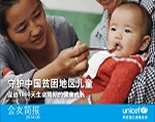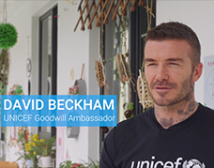GENEVA, 26 January 2016 – UNICEF is launching a US$2.8 billion appeal to reach 43 million children in humanitarian emergencies worldwide.
For the first time ever, the largest portion of the appeal – 25 per cent – is going towards educating children in emergencies. This year UNICEF plans to dramatically increase the number of children in crises who are given access to education – from 4.9 million at the beginning of 2015 to 8.2 million in 2016. More than half - 5 million – will be Syrian children inside the country or in neighbouring countries.
“Millions of children are being robbed of their education,” says Afshan Khan, UNICEF's Director of Emergency Programmes. “Education is a life-saving measure for children, providing them with the opportunity to learn and play, amidst the carnage of gunfire and grenades. This year, a quarter of our appeal is devoted to education. By educating the minds of children and young people we are building hope so they can envisage a better future for themselves, their families and their societies and help break the cycle of chronic crisis.”
UNICEF's 2016 appeal has doubled since this time three years ago. The twin drivers of conflict and extreme weather are forcing growing numbers of children from their homes and exposing millions more to severe food shortages, violence, disease, abuse, as well as threats to their education.
Around 1 in 9 of the world's children is now living in conflict zones. In 2015, children living in countries and areas affected by conflict were twice as likely to die of mostly preventable causes before they reached the age of five, than those in other countries.
Climate change is a growing threat, with over half a billion children living in extremely high flood occurrence zones and nearly 160 million living in high or extremely high drought severity zones. One of the strongest El Niño weather events on recordposes further risk.
The number of people forced from their homes continues to grow, with Europe alone receiving more than 1 million refugees and migrants in 2015.
“In the past few months I have seen with my own eyes children pushed beyond the boundaries of human suffering in Burundi, northeast Nigeria and along the migrant and refugee route in Europe,” says Khan. “Across the world, millions of children have been forced to flee their homes due to violence and conflict. The global refugee crisis is also a protection crisis for children on the move, who are at increased risk of abuse, exploitation and trafficking.”
UNICEF's Humanitarian Action for Children 2016 appeal targets a total of 76 million people, in 63 countries.
-
The largest section of the appeal – US$1.16 billion – is allocated to life-saving aid needed for Syria and the Syrian refugee crisis in Egypt, Iraq, Jordan, Lebanon and Turkey. Key needs include safe water, immunizations, education and child protection.
-
US$30.8 million is being requested by UNICEF to respond to the refugee and migrant crisis in Europe.
-
UNICEF is calling for US$180 million for children in Yemen where almost 10 million children are in urgent need of humanitarian aid in a conflict which is heading towards its first anniversary.
-
UNICEF is appealing for US$25.5 million to help protect children in Burundi, one of the poorest countries in the world, and to provide aid to Burundian refugees who have fled to Rwanda and Tanzania.
-
UNICEF is asking for US$188.9 million to respond to the humanitarian needs in Nigeria, Cameroon, Niger and Chad, including addressing the consequences of the violence in northeast Nigeria.
UNICEF's appeal also covers severely underfunded emergencies – including protracted crises in Afghanistan, the Democratic Republic of the Congo and Sudan which were all less than 40 per cent funded in 2015.
Funds raised by UNICEF will be used for immediate humanitarian response, as well as longer term work to prepare countries for future disasters.
In 2015, UNICEF reached millions of children with humanitarian aid – including providing 22.6 million people with access to safe water, vaccinating 11.3 million children against measles, treating 2 million children for the most serious form of malnutrition, offering 2 million children vital psychological support and giving 4 million children access to basic education.
# # #
The full Humanitarian Action for Children 2016 appeal and related country information can be found here from 10:30 GMT on 26th January 2016: www.unicef.org/appeals
Video and photos are available for download here: http://uni.cf/1RTmcsI
Notes to Editors
The 63 countries and areas featured in the Humanitarian Action for Children 2016 appeal are highlighted due to the scale of these crises, the urgency of their impact on children and women, the complexity of the response, and the capacity to respond.
About UNICEF
UNICEF promotes the rights and wellbeing of every child, in everything we do. Together with our partners, we work in 190 countries and territories to translate that commitment into practical action, focusing special effort on reaching the most vulnerable and excluded children, to the benefit of all children, everywhere.
For more information about UNICEF and its work visit: www.unicef.org
Visit UNICEF China website: www.unicef.cn
Follow us on Sina Weibohttp://weibo.com/unicefchina
Tecent Weibohttp://t.qq.com/unicef
Wechat: unicefchina

For more information, please contact:
Christophe Boulierac, UNICEF Geneva, Tel: +41 (0)22 909 5716, Mobile: +41 (0) 799639244, cboulierac@unicef.org
Rose Foley, UNICEF New York, Tel:+ 1 212 303 7987, Mobile: + 1 917 340 2582, rfoley@unicef.org
Najwa Mekki, UNICEF New York, Tel: +1-212-326-7448, Mobile: +1 917 209 1804 nmekki@unicef.org





























